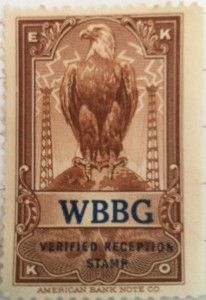When people think of Mattapoisett history, whaling shipbuilding normally comes to mind. However, the town has another, lesser-known distinction: the first female radio announcer in New England hailed from none other than Mattapoisett.
Eunice Randall Thompson – the aunt of former Selectman George Randall and a noted radio announcer and engineer – recently was posthumously inducted into the Massachusetts Broadcaster Hall of Fame.
This past fall, Mattapoisett residents and relatives of the late engineer – Eunice Stolecki, Cheryl Randall and Pierce Randall – ventured out to Quincy, MA to attend a gala awards ceremony and luncheon that honored this woman’s role in radio history.
Born in 1898, Eunice was raised on a Massachusetts farm on Randall Lane (at 29 Randall Lane, which incidentally includes the town’s oldest house built in 1741) but envisioned for herself a life different than other women from her era.
She taught herself Morse Code and learned all about ham radio (or amateur radio) – and a chance encounter with another radio pioneer, Irving Vermilya, led to a mentorship that helped her pick up the skills to be hired as the first female radio engineer for the AMRAD station 1XE on Medford Hillside. She later went on the air of Boston’s first radio station in 1922.
Over the years, Eunice had a successful career as an engineer and radio expert/consultant who was active in the Eastern Massachusetts Amateur Radio Association and South Shore Amateur Radio clubs. During World War II she volunteered for WERS and taught code to aspiring amateurs. She passed away in 1982 in Maine, where she resided with husband Ken Thompson.
“I don’t think people realize the importance of Mattapoisett in radio history,” commented Donna Halper, a noted radio historian, consultant, author, university professor and radio announcer who herself broke ground as the first woman announcer at Northeastern University in Boston in the 1960s. Ms. Halper has thoroughly researched the lives of Eunice and Mr. Vermilya – a “ham radio legend for 40 to 50 years” from Mattapoisett who passed away in 1964.
In particular, Ms. Halper has worked hard to bring Eunice’s contributions to radio to the public’s attention – which she feels were omitted from many narratives on early broadcast history due to her gender.
But Ms. Halper’s interest in Eunice is personal as well.
“I’ve been the first woman in every place I’ve been. What I really wanted to know, is who is my mother?” Ms. Halper said.
Eunice likely did not consider herself a feminist, Ms. Harper said, but “wanted to follow her own path. I don’t think she believed in stereotypes.” However, she “tried to change the language” of radio, especially in her insistence of bring called a “draftslady” instead of “draftsman”.
As an accomplished radio engineer and announcer, “she had her foot in both worlds.”
Cheryl Randall, the great niece of Eunice, remembered her as a woman of great stature (she was 6’4” tall) who taught her Braille as a child.
“We’d write letters back and forth in Braille. It was really cool,” she said. Although Ms. Randall said not everyone in her family was accepting of her decision to not “stay home and have babies” – the women generally supported her.
Back in the day, Ms. Randall said Eunice built a receiver at the Randall Road home so family could listen to her broadcasts.
“She ran a wire through the woods. It was pretty amazing,” she said, adding that some of the old wires are still visible on the property today.
In addition to her engineering prowess, both Ms. Randall and Ms. Halper describe Eunice’s voice as powerful.
Ms. Halper said that recording technology was developed much later than Eunice’s original broadcasts, thus “for the most part recollections are only through memories of those who were there.”
However, the Edison Company in 1937 gathered up well-known announcers for a re-enactment of their shows – offering Ms. Halper a coveted chance to hear her idol’s voice.
“You can hear what an incredible voice she had: a deep rich contra alto. It was pretty amazing listening to her,” said Ms. Halper – adding a footnote that in the past, the old microphones distorted voices so women’s voices sounded higher and men’s voices sounded lower in pitch.
“She had such a great voice. She used to sing. She was the total package,” Ms. Randall said about her great-aunt. She recalled that the radio pioneer encouraged her to get her poetry published in a magazine.
“She was an inspiration. I was lucky to grow up knowing her. Those were different times, and that generation is so special,” she said.
Ms. Halper has a strong interest in the friendship between Eunice and Mr. Vermilya – the man who offered to teach her after randomly picking up her amateur Morse coded messages at his home two towns away around 1918.
He had responded in code, “Your daddy didn’t teach you right, little boy.” After responding, Eunice had added, “And by the way, I’m not a little boy, I’m a girl.” From that point, Mr. Vermilya offered to teach her more about ham radio and the two became lifetime friends.
“Talk about chance in bringing two people together,” Ms. Halper commented. “Eunice was a true friend to him.”
Of the two personalities from Mattapoisett who shaped radio, she said, “Their stories are so important to the people who created my industry.”
